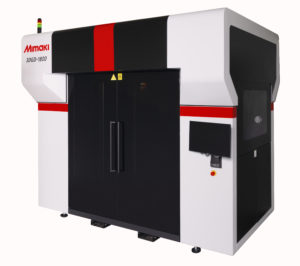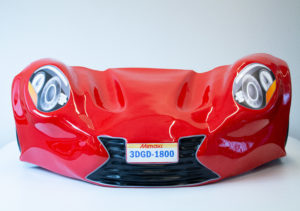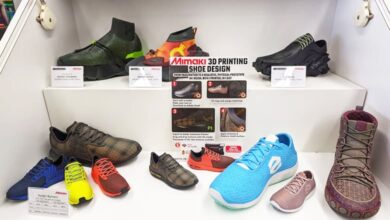Exclusive: One on One with Ronald van den Broek, Mimaki’s General Sales Manager

Drupa is not the only big graphic arts show that has been postponed. Other trade events including Fespa had to follow suit due to ongoing pandemic. Fespa will take place in fall,but many vendors including Mimaki couldn’t wait that long. So the company held its own Virtual Press Festival, from March 24 until May 1.
Mimaki is also focusing on 3D printing big time. The company recently introduced a new large format 3D printer,Mimaki 3DGD-1800(with GD standing for Gel Dispensing). The machine can produce hollow objects up to 1.8 meters in height in about seven hours.
In light of these new developments ME Printer talked to Ronald van den Broek, Mimaki’s General Sales Manager to find out more about company’s plan for the future and post Covid strategy.
What concrete steps Mimaki is taking to protect environment?
At Mimaki, we make sure that we follow safety guidelines and that our products are certified according to local standards and regulations. Our sublimation inks, for example, are certified with ECO PASSPORT by OEKO-TEX, which proves that there is no harmful effect to humans or the environment in which the textiles are treated using the inks. Recently, we also introduced new eco-cartridge for our 600ml SS21 inks, which can be reused to reduce plastic waste.
Furthermore, we work with our partners and other manufacturers to provide environmentally conscious solutions for our customers. Our distributor in the UK, for instance, runs a solvent cartridge recycling scheme. In April, we announced our upcoming collaboration with BOFA to design a custom air purifier unit for one of our wide-format solvent machines to promote an even safer work environment.

What was and is Mimaki’s contribution to the fight against coronavirus?
Since the outbreak of COVID-19, we at Mimaki have been working hard to ensure we maintain communications with our customers and support them through this difficult time. Under normal circumstances, we would be interacting with our customers face-to-face at events, instead we have set up a series of virtual events to help keep the industry connected and thriving. In fact, our virtual Mimaki Live events have been exploring ways in which printers, whether they specialize in textiles, large format, 3D or signage, can keep their business going and even be reinvigorated during these trying months.
In addition, in the aftermath of COVID many of our customers, such as Italian printer Energiapura, are utilizing Mimaki’s printers to quickly produce face masks to help reduce the spread of coronavirus. We are at their side, determined to support and help them overcome this challenging time.
You are offering a wide range of printers in different format and for different applications including 3D printing, which areas of applications have a better prospect and a faster growing rate: textile, decor, 3D printing……?
Based on the evolution of the market, as well as on the direct feedback from our customers during our virtual live events, we would say that home textiles and technical textiles are experiencing extensive growth and are expected to further increase in the near future. The same applies to the soft signage and retail signage spaces, as they retail units begin to re-open.
We also see 3D printing experiencing a lot of growth over next few years, with its ability to produce stand-out, interactive signage and models quickly and easily. We believe that 3D printers such as Mimaki’s 3DGD-1800 have great potential in transforming the signage industry.

In which way current pandemic affected your company and your strategy for launching new products?
As expected, COVID has indeed impacted the company, and we have seen fewer hardware and consumer sales over the past few months compared to that of last year. It is more important than ever in these circumstances to plan ahead, and so we have adopted the following 4-point strategy moving forward:
Major impact – See in what area the business is impacted the most and identify the new priorities of the customers.
Prepare to withstand the impact – Make sure we can sufficiently support our partners and distributors.
Returning to normal – How can Mimaki help and what support will the respective governments offer in the aftermath.
Sort out the industry dynamics – See how the buying behaviour has changed following the pandemic, and whether it will have any long-term changes.
It is important for us to bear these stages in mind before and while we launch new products, but as you can see our attention is primarily focused on helping our partners and distributors through this crisis at this time.
The widest large format printer you are offering is 3.2 meters, why you never ventured into manufacturing 5-meter super wide format printers?
We probably have the most extensive line-up of large format printers, covering different segments: sign graphics, textile, 3D and industrial markets. Manufacturing 5m super wide format printers is not in our strategy at the moment, simply because we have other products that we currently focus on. In the past two years, for example, you can see that we’ve come a long way with our 3D and textile print technologies.
Wide format and signage are playing important role during ongoing Covid pandemic. They are even classified as “essential”, do you see more opportunity for Mimaki in signage industry in post Covid era?
Certainly, despite the reduction in retail signage, COVID guidance signs are one such example of how signage is being widely used during the crisis. Post-COVID, I imagine that retail will want to keep their displays flexible, as things slowly get back to normal – and this is where Mimaki’s digital printers can help provide swift and easy signage printing.
Packaging has largely been immune to the effects of Coronavirus, does Mimaki have plan to get more involved in the different areas of packaging industry including printing on corrugated board?
Our UV printers are capable of printing on corrugated board, even though these are mostly used for producing custom packaging, mock-ups, or a small run. While the packaging industry is interesting for us, as of now we do not have any plans to get more involved in this market. But if we do, we will definitely let you know.
Ghent Workgroup (GWG) recently launched new specification for sign and display in order to solve the problem of apparent resolution and actual resolution and enable graphic arts professionals to create, process and exchange high quality print files for a wide variety of applications, do you think this initiative and initiatives similar to this help large format industry to find common ground?
Definitely. LFP is such a multilayered industry that covers a large variety of products, from banners and exhibition displays to vehicle wraps and window graphics. Therefore, standardization and guidelines are required to help companies set clear expectations of quality and consistency for their customers. They also help printers to work toward improving their workflow productivity and efficiency – and eventually to print with confidence.
What are recent developments in ink, many thought the death of solvent ink is imminent but that hasn’t happened yet, Why?
Solvent is here to stay as it is the most affordable and proven option out there for signage graphics. Other inks will co-exist with solvent and, at the end of the day, it depends on the business needs of each printing company. This is because other inks, such as UV-curable inks, offer different properties compared to those of solvent, which can be suitable for printing companies looking for a more sustainable option or printing on more varied materials.
Does the term Eco solvent represent just a marketing gimmick or is it truly Ecological or maybe economical rather than eco logical?
It depends on how each company chooses to communicate this to the masses. In our case, Mimaki’s eco-solvent inks produce less VOCs compared to the solvent ones and they do not require any special ventilation facility. However, our solvent inks, such as the SS21 and BS4, are certified GREENGUARD Gold, meaning that they pass strict health-based criteria for additional chemicals and VOC emissions levels. This ensures that products of these inks are acceptable to use in environments like schools and healthcare facilities.
Unlike other parts of industry like textile or packaging, there have not been very many earthshaking product announcements in the wide format space, why?
I partly agree with this statement because the wide format space is quite saturated. The textile industry, on the other hand, is experiencing a shift toward digital printing technology because more than 90% of global textile production is still done via conventional techniques.
With that being said, there are still announcements within the wide format sector that are worth noting, such as recent ink developments. UV-curable inks, for example, are getting more popular and accessible than ever.
Another game-changing development in wide format is the introduction of new tech such as 3D printing. We’ve recently announced the Mimaki 3DGD-1800, a large-scale 3D printer. With the introduction of this machine, our customers can now combine 2D and 3D printing to create one-of-a-kind signage – for example: they can print a 3D model of a car bumper, wrap it with printed vinyl and mount it on a billboard to make it appear as if a car is coming out of the ad. The creative possibilities are endless!





